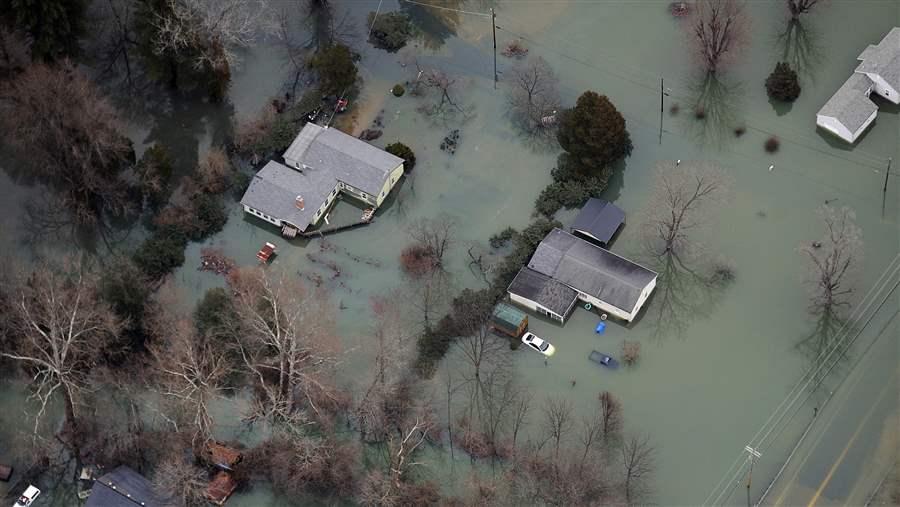National Flood Insurance Program Needs Reform to Better Prepare for the Future
Changes must reduce debt and effectively address risk
 © Vesna Andjic/iStock
© Vesna Andjic/iStockOverview
The National Flood Insurance Program (NFIP), created in 1968, provides federally backed coverage for homeowners and small businesses in more than 22,000 flood-prone communities across the United States. Established to offset a lack of private sector flood insurance and to help reduce federal spending on disaster response and rebuilding, the NFIP now has more than 5 million policies.1
Governed by congressional mandates and administered by the Federal Emergency Management Agency (FEMA), the program provides coverage to a home or business in a participating community, even after multiple losses. Communities elect to join the NFIP and adopt flood plain management rules to obtain lower-cost insurance rates for the homes and businesses in their areas. Properties built before a community joined the NFIP, and those included in a flood map after topographical or development changes prompted creation or expansion of a federal flood zone, are eligible for insurance rates that FEMA estimates may be 45 to 50 percent below a full-risk rate. As a result, taxpayers and policyholders with structures built to higher standards or outside of flood-hazard areas subsidize those properties.2
Flooding is the fastest-growing and most-costly natural disaster in the United States, and federal legislators should act to better protect ratepayers and taxpayers.
Nearly $24 billion in debt
In its oversight role, Congress has set limits on rate increases and directed the program to borrow from the U.S. Treasury rather than build up capital to respond to catastrophic storms or flood events. Then, in 2012, when the program’s debt exceeded $17 billion, Congress authorized fee collection from policyholders in an effort to develop a contingency fund. But those efforts have been inadequate to address mounting claims and losses. The program’s debt has ballooned to nearly $24 billion, and its borrowing limit—a congressionally established ceiling for Treasury-provided funds— has reached $30.4 billion. Experts estimate that repayment of the debt would require decades free of catastrophic storms. Citing the program’s importance, financial instability, and predicted future risk, the Government Accountability Office has included the NFIP on its yearly list of high-risk government programs since 2006.3
Recent congressional action
In 2012, Congress passed the Biggert-Waters Flood Insurance Reform Act, which attempted to put the NFIP on stronger financial footing by phasing in insurance rate increases to reflect actual risk for some of the most heavily subsidized properties.4 However, two years later Congress rolled back many of the provisions in response to concern from policyholders about the rising cost of premiums. The 2014 Homeowner Flood Insurance Affordability Act provided refunds to some policyholders who had incurred large premium increases, allowed subsidized rates to convey when properties are sold, and capped rate increases for individual homeowners.5
Fair and sustainable solutions
The NFIP is due to be reauthorized in 2017, which presents Congress with an opportunity to make needed changes. Flooding is the fastest-growing and most-costly natural disaster in the United States, and federal legislators should act to better protect ratepayers and taxpayers by:
- Encouraging communities to improve management of the most flood-prone areas.
- Linking buyouts of flood-prone properties with protection and restoration of natural resources.
- Protecting homebuyers by requiring sellers to accurately and fully disclose flood history and risk.
- Providing ratepayers with information about their actual flood risk.
Endnotes
- Federal Emergency Management Agency, National Flood Insurance Program, “Resources: Flood Facts,” last updated May 9, 2016, https://www.floodsmart.gov/floodsmart/pages/flood_facts.jsp.
- Government Accountability Office, Flood Insurance: Forgone Premiums Cannot Be Measured and FEMA Should Validate and Monitor Data System Changes (December 2014), http://www.gao.gov/assets/670/667413.pdf; and Association of State Floodplain Managers, National Flood Programs & Policies in Review (2015), http://www.floods.org/ace-files/documentlibrary/committees/NFPPR_20150128/NFPPR_2015.pdf.
- Government Accountability Office, High-Risk Series: An Update (February 2015), http://www.gao.gov/assets/670/668415.pdf.
- Federal Emergency Management Agency, “Biggert Waters Flood Insurance Reform Act of 2012: Impact of National Flood Insurance Program (NFIP) Changes” (April 2013), http://www.fema.gov/media-library-data/20130726-1909-25045-0554/bw12_sec_205_207_factsheet4_13_2013.pdf.
- Federal Emergency Management Agency, “Homeowner Flood Insurance Affordability Act: Overview” (April 3, 2014), http://www.fema.gov/media-library-data/1396551935597-4048b68f6d695a6eb6e6e7118d3ce464/HFIAA_Overview_FINAL_03282014.pdf.







